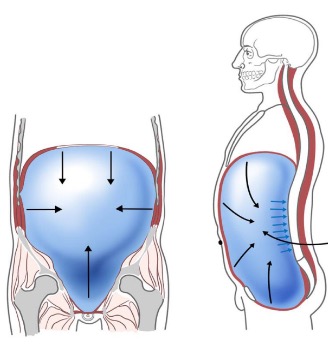If you are reading this article, you most likely have some affiliation with our office. [Core] Chiropractic and Wellness has been fortunate to serve the residents of the Roanoke, Virginia area now for several years. Every once in awhile we get the question of where we got our name. In this week’s blog article, we thought we would take a little time to share with you the story of our name.
Background
During my chiropractic training, I was often challenged by my mentors to seek out the ‘why’ of a patient’s condition. It is often easy to diagnose what is wrong with the patient. A torn meniscus, herniated disc, or Achilles tendonitis are all diagnoses that tell us what is wrong. It is much more difficult to answer the question, “Why did this happen?” More often than not, no matter what the diagnosis, the “why” leads to the foundation of every movement, or the “core.”
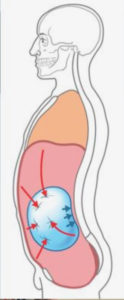 The Core
The Core
The word “core” can mean a lot of things; it can mean the middle, the foundation, or the center. When we talk about the core in chiropractic terms, we often refer to the area between the ribs and pelvis that is surrounded by musculature: front, back, both sides, above and below. This core is the middle of the body, the foundation for movement, and the center of mass for the human frame. The core is what provides stability and strength to the spine and, when strong enough, it will prevent injury. Every motion we make (walking, throwing, jumping, rolling over, etc.) starts with stabilization of the spine by the core muscles. This occurs automatically and is required for safe and purposeful movement.
Because of the importance of the core to the body and its necessity for pain-free movement and function, we thought the word [Core] would be perfect. Knowing how to properly use the core and how best to keep it fit are very important to overall health. Below are some highlights of what the core does and how best to keep it functioning properly.
How To Use the Core
Using the core involves co-activation of the entire abdominal wall including the thoracic and pelvic diaphragms. The thoracic diaphragm may be the most important muscle in the core because as it descends during contraction, the diaphragm drives the co-contraction of the abdominal musculature. This creates pressure in a 360-degree fashion around the abdomen and, in turn, provides support and stability to the lumbar spine. The amazing thing about the core muscles is that the amount of contraction of the core can vary depending upon the task that is being accomplished. This allows us to safely pick up a pencil or a heavy box of books with similar movements and stability.
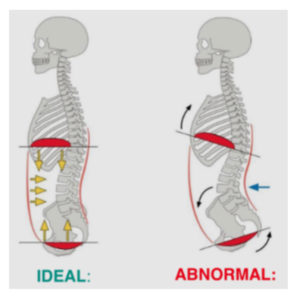 When Things Go Wrong With the Core
When Things Go Wrong With the Core
If one muscle or even a part of a muscle does not provide the correct stabilization needed for a purposeful movement or activity, dysfunction will occur. This causes compensatory mechanisms that will lead to overuse of a muscle (trigger point) or a joint (degeneration/arthritis). This can lead to further structural damage and often to chronic pain.
One major compensation pattern that can happen with the dysfunction of the core is massive concentric activity of the lumbar erectors or overdominance of the anterior abdominal muscles. This creates what Pavel Kolar M.D., refers to as the “Open-Scissor Position.” This non-ideal position of the rib cage and pelvis prevents efficient pressurization of the abdomen and in turn, a non-ideal stabilization.
Patients who demonstrate this type of posture generally inhale with their chest and not their abdomen. Commonly known as a “Chest Breather”, these patients frequently have low back pain and/or chronic upper back pain.
They will exhibit rope-like muscles in the back and neck as these muscle groups become overly tight as they become overworked for both joint stability and movement. These aberrant stabilization patterns are the foundation of many chronic pain conditions including disc bulges, migraine headaches, chronic low-back pain, and more.
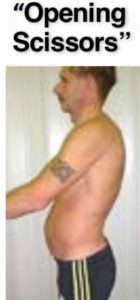 |
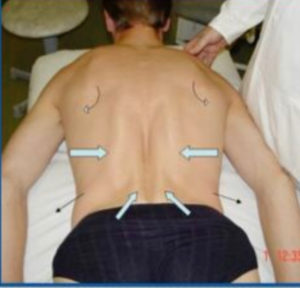 |
|---|
How To Target Your Core
A great exercise to reduce the Open Scissor compensation pattern and to help the core return to normal function is the Dynamic Neuromuscular Stabilization exercise known as the 4-month supine position.
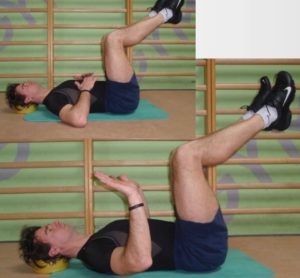 4-Month Supine Position
4-Month Supine Position
- Start on your back with a small pillow or towel under your head.
- Lift the knees up to place the knees and hips both in 90 degrees, keeping each foot and knee from touching each other at all times. Place hands palm face up to the ceiling.
- Important! – Avoid lifting the lower rib cage up off of the floor at all times. Keep the low back and lower ribs on the floor throughout the exercise.
- Breathe fully into the pelvis, feeling for the entire abdomen to expand during inhalation. Avoid breathing through the chest and upper ribs.
- Repeat breathing repetitions of 7-10 repetitions for 3 sets. If at anytime the lower rib cage or low back rise up and break contact with the floor or if the legs start to drop back to the floor, stop and reset the exercise.
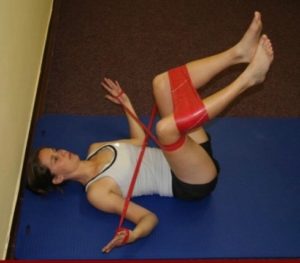 Progressions:
Progressions:
- When you can successfully stabilize and breathe in the 4-month position, you are ready to progress the exercise. Remember to keep stabilization and breathing throughout the exercise.
- Progression 1– Alternate lowering each leg just a few inches and return it to the starting position. You can also open the hip by letting the knee fall open to the side from the starting position.
- Progression 2– Tie a resistance band around the knees and perform the leg movements from progression 1.
- Progression 3– Use a pulley machine or hand weights and perform tricep exercises, pec fly, reverse fly, and/or rotator cuff external rotation exercises. The amount of weight in these exercises is minimal as the point of the exercise is to challenge the core more than building strength.
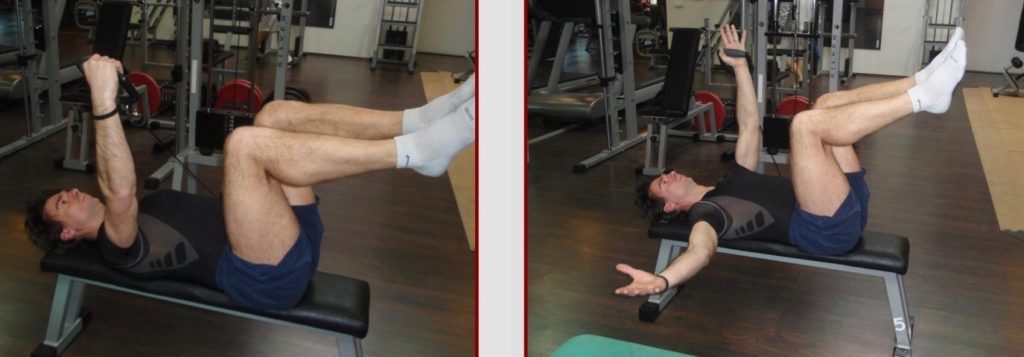
To summarize, the core is the most important functional group of muscles in the body. It is the first muscle group to contract and stabilize for nearly every movement. The more load/demand necessary, the more the core is needed to stabilize the spine. The position of the ribcage in relation to the pelvis is essential in creating the ideal stabilization and preventing injury and spine degeneration.
Likewise, we hope that [Core] Chiropractic and Wellness becomes one of the most important parts of your and your family’s health and wellbeing. We strive to educate, inform, and provide resources for you to make the health decisions that best benefit you. If there is any way we can help you or your family members, please reach out and contact us. We look forward to partnering with you and helping you become healthier than you have ever been.

Daryl C. Rich, D.C., C.S.C.S.

